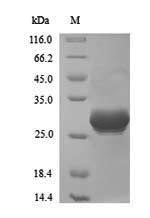Recombinant Vaccinia virus Complement control protein C3 (VACWR025) is produced in yeast and contains the complete mature protein sequence from amino acids 20 to 263. The protein carries an N-terminal 6xHis tag, which makes purification and detection more straightforward. SDS-PAGE analysis shows the protein achieves greater than 90% purity, suggesting consistent quality for experimental work. This product is designed for research use only.
The Vaccinia virus Complement control protein C3 appears to play a key role in dampening host immune responses. It seems to contribute to the virus's strategy for avoiding immune detection by blocking parts of the complement system—a critical component of our innate immune defenses. Studying how this protein works and what it interacts with may be essential for understanding viral disease mechanisms and immune system dynamics.
Potential Applications
Note: The applications listed below are based on what we know about this protein's biological functions, published research, and experience from experts in the field. However, we haven't fully tested all of these applications ourselves yet. We'd recommend running some preliminary tests first to make sure they work for your specific research goals.
Based on the provided information, recombinant Vaccinia virus VACWR025 is produced in a yeast expression system as a partial fragment (20-263aa) with an N-terminal 6xHis-tag. This viral protein is designed to interact with and regulate the host complement system, requiring precise folding and functional domain integrity for its immune evasion activity. While yeast expression systems provide eukaryotic folding machinery capable of supporting disulfide bond formation and some post-translational modifications, viral proteins often have unique structural requirements that may not be fully replicated in heterologous systems. The partial nature of the fragment (missing potential N-terminal residues) and the presence of the His-tag may affect proper folding and functional activity. No validation data (e.g., complement binding assays, functional activity tests) are provided. Therefore, while yeast expression increases the probability of correct folding compared to prokaryotic systems, the protein's folding status and bioactivity cannot be confirmed without experimental validation.
1. Complement System Interaction Studies
If correctly folded, this recombinant protein could be used to study interactions with human complement proteins, as the His-tag facilitates immobilization for binding assays. However, if misfolded, functional domains may be altered, leading to non-specific binding or failure to recognize genuine complement components, compromising the validity of viral immune evasion mechanisms studied.
2. Antiviral Drug Screening Platform
If properly folded and functional, the protein could serve as a target for screening compounds that disrupt viral complement evasion. However, if misfolded, screening would identify false positives/negatives, as the protein would not accurately represent the native viral protein's interaction with complement factors.
3. Antibody Development and Characterization
This application is suitable, as antibody generation primarily relies on linear epitope recognition. The high purity and defined fragment support consistent immunization results. However, if misfolded, antibodies may not optimally recognize conformational epitopes of the native viral protein in biological contexts.
4. Protein Structure-Function Analysis
If correctly folded, the fragment could provide insights into the viral protein's structural features. However, if misfolded, structural data would misrepresent the native architecture, and the partial nature limits understanding of full-length protein function in complement regulation.
Final Recommendation & Action Plan
This yeast-expressed partial viral protein requires validation before functional applications due to the unique structural requirements of viral immune evasion proteins and the challenges of expressing them in heterologous systems; the recommended action plan includes: first validating folding through biophysical methods (circular dichroism for secondary structure, size-exclusion chromatography for oligomeric state) and functional assays (complement binding or inhibition tests); if validation confirms proper folding and activity, proceed with applications while noting the limitations of the partial fragment; if misfolded, consider using alternative expression systems (e.g., mammalian cells) that may better support viral protein folding or obtain a commercially validated standard; for immediate use, antibody development can proceed but validate antibodies against native viral protein; avoid functional studies until proper folding and bioactivity are confirmed. Always include appropriate controls (e.g., known complement proteins, validated inhibitors) in experiments to ensure reliability.






